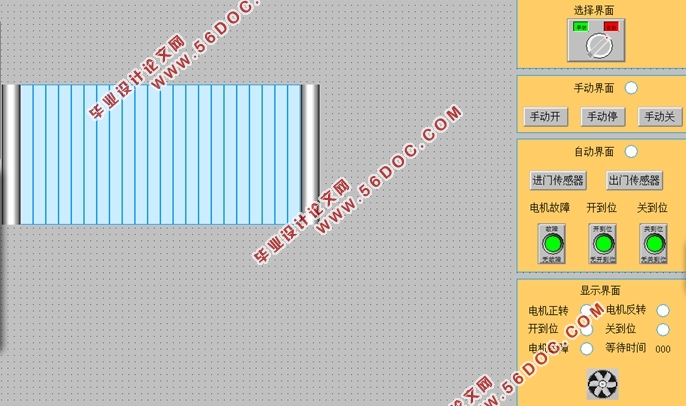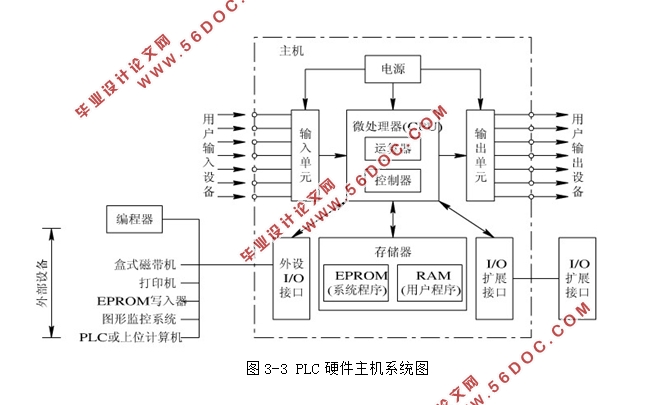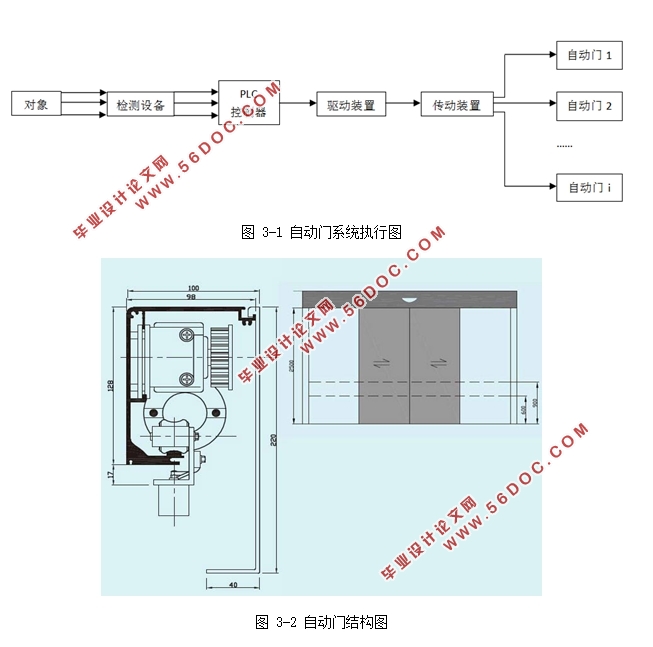基于PLC的自动门系统的分析与设计(附梯形图程序,组态)
来源:56doc.com 资料编号:5D22265 资料等级:★★★★★ %E8%B5%84%E6%96%99%E7%BC%96%E5%8F%B7%EF%BC%9A5D22265
资料以网页介绍的为准,下载后不会有水印.资料仅供学习参考之用. 密 保 惠 帮助
资料介绍
基于PLC的自动门系统的分析与设计(附梯形图程序,组态)(论文13700字,外文翻译,梯形图程序,组态)
摘要:在人们的日常生活中,自动门的应用已经越来越常见。人们渐渐对自动门的安全性和性能有了更高的要求。由于PLC(Programmable Logical Controller)稳定性高并且环境适应能力强的特点,它在自动门控制领域的应用越来越广。
本文针对PLC控制的自动门展开研究。首先分析了国内外自动门的发展状况以及所用到的控制技术,然后对该控制系统进行分析。按照自动门的控制要求,设计硬件电路,编写软件程序,以及组态仿真,实现由检测到开门到计时再到关闭的过程。
本设计主要的工作原理是通过信号采集装置判定有无人经过并将信号转换成开关量信号传到PLC,PLC根据开关信号来控制变频器的开停和速度的变换,在由传动装置带动门运动
关键词:PLC可编程控制器;自动门;传感器;设计原理;工作原理
PLC automatic door control system
Abstract: Automatic doors have been widely used in the people's daily lives. Then, requirements of their performance and security are getting higher and higher. Owing to the high stability and strong adaptation to the environment, the application of PLC in auto-door control unit is also increasingly widespread.
This paper investigates auto-door control system. Firstly, Development trend the automatic doors and the used technologies are introduced at home and abroad. Then, a brief description of the PLC system is provided. In accordance with the requirements of automatic door control device, ladder diagram files are designed, which achieves the whole process of detecting, opening, waiting and closing of the automatic door.
The main working principle of this design is through the signal acquisition device to determine whether if there is the one passing. Then, the signal is converted into a switch signal to the PLC. And the PLC controls the start and stop of the drive and the speed change according to the switch signal, and the door is driven by the device of transmission.
Key words: PLC programmable controller; Automatic door; The sensor; The principle of design;
The working principle
本次设计的自动门控制系统包含了西门子PLCS7-200控制系统和传感器、继电器等各种执行元件。采用的PLC为控制中心来控制传动机构,从而控制门的自动打开与关闭,从而实现门的自动化控制。
本设计以PLC为控制器,设计自动门控制系统。第二章主要介绍自动门的主体结构,包括控制结构图,以及功能要求等;第三章介绍硬件结构,包括电机,光电传感器,PLC控制器的概述,选型,CPU输入输出端口的选择还有硬件电路等;第四章是软件部分,展示了梯形图程序和组态仿真界面的截图;第五章则是总结本次设计。仿真视频在附件中给出。




目 录
1 绪论 1
1.1研究自动门控制系统的目的和意义 1
1.1.1研究自动门控制系统的目的 1
1.1.2研究自动门控制系统的意义 1
1.2自动门的研究现状 1
1.2.1国内自动门发展现状 1
1.2.2 国外自动门发展现状 2
1.2.3 自动门控制发展趋势 3
1.2.4 自动门的前景与未来 3
1.3 论文研究的安排 4
2 整体结构设计 5
2.1自动门的功能需求分析 5
2.2自动门的控制要求 5
2.3自动门控制系统构成 6
3 硬件设计 8
3.1 电动机装置 8
3.1.1 电动机的介绍与分类 8
3.1.2 电动机的工作原理 8
3.1.3 电动机的选型 9
3.1.4 电动机正反转 9
3.2 传感器 9
3.2.1 传感器的概念与特点 9
3.2.2 传感器的分类 10
3.2.3 传感器的选型 11
3.2.4 光电传感器应用 11
3.3 PLC硬件设计 12
3.3.1 PLC的概述 12
3.3.2 PLC的硬件系统 12
3.3.3 PLC的分类 12
3.3.4 PLC的工作原理 13
3.3.5 方案设计 14
3.3.6 PLC的选型及I/O口分配 14
3.3.7 PLC的硬件模板 15
3.4 硬件系统的主控制电路设计 16
3.4.1 自动门控制系统原理框图 16
3.4.2 自动门控制系统硬件组成框图 17
3.4.3 接触器和热继电器的概述 17
4 软件设计 22
4.1 PLC软件设计 22
4.1.1 STEP7软件的介绍 22
4.1.2 系统分析及设计 22
4.2 组态软件设计 28
4.2.1 组态软件的介绍 28
4.2.2界面设计 29
4.2.3 数据库组态设计 29
4.2.4 变量链接 30
5 结论 34
参考文献: 35
致 谢 36
|









